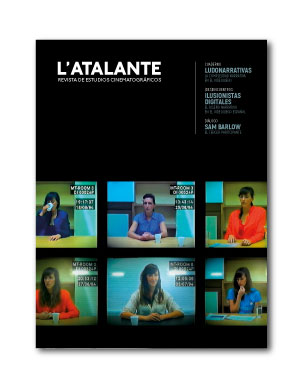El demonio del gameplay emocional está en los detalles. Microanálisis de escenarios de complejidad afectiva en videojuegos
Publicado 30.01.2021
Palabras clave
- Videojuegos,
- Complejidad,
- Emoción,
- Microanálisis,
- Experiencia.
Cómo citar
Derechos de autor 2021 L'Atalante. Revista de estudios cinematográficos

Esta obra está bajo una licencia internacional Creative Commons Atribución-NoComercial-SinDerivadas 4.0.
Resumen
Este artículo propone una exploración y conceptualización de los escenarios de complejidad emocional en videojuegos, desde un enfoque basado en el análisis textual del videojuego, la teoría de la experiencia emocional del espectador y el microanálisis fílmico. Desde este prisma teórico-metodológico, los escenarios de complejidad emocional del videojuego se abordan como breves pasajes o conjuntos de pasajes de un videojuego, donde tiende a suscitarse una experiencia afectiva caracterizada por mezclas o tensiones emocionales singulares, y cuya comprensión requiere un análisis micro del diseño lúdico y narrativo de la escena y las interacciones entre ambas dimensiones, sin olvidar el relevante papel de la puesta en escena y la composición del plano.
Descargas
Citas
Anable, A. (2018). <em>Playing with Feelings</em>. Minneapolis: University of Minnesota Press.<br>
Berlant, L. (2011). <em>Cruel Optimism</em>. Durham: Duke University Press.<br>
Bogost, I. (2006). <em>Persuasive Games</em>. Cambridge: MIT Press.<br>
Bordwell, D. (1996). <em>La narración en el cine de ficción</em>. Barcelona: Paidós.<br>
Buckland, W. (ed.) (2009). <em>Puzzle Films</em>. Oxford: Wiley-Blackwell.<br>
Deleyto, C. (2003). <em>Ángeles y demonios. Representación e ideología en el cine de Hollywood</em>. Barcelona: Paidós.<br>
Fernández-Vara, C. (2015). <em>Introduction to Game Analysis</em>. Nueva York: Routledge.<br>
Fullerton, T. (2008). <em>Game Design Workshop</em>. Nueva York: Morgan Kaufman.<br>
García-Catalán, S., Sorolla-Romero, T., Martín-Núñez, M. (2019). Reivindicar el detalle: sutilezas y catálisis barthesianas en la ficción televisiva. <em>Palabra Clave, 22</em>(3). http://doi.org/10.5294/pacla.2019.22.3.3<br>
Gregg, M., Seigworth, G. (2010). <em>The Affect Theory Reader</em>. Durham: Duke University Press.<br>
Grodal, T. (2009). <em>Embodied Visions. Evolution, emotion, culture and film</em>. Oxford: Oxford University Press.<br>
Hocking, C. (2007, 7 octubre). Ludonarrative dissonance in Bioshock: The problem of what game is about. Post de blog. http://clicknothing.typepad.com/click_nothing/2007/10/ludonarrative-d.html<br>
Hunicke, R., Leblanc, M., Zubeck, R. (2004). MDA: a formal approach to game design and game research. <em>Proceedings of the AAAI-04 Workshop on Challenges in Game AI.</em><br>
Igartua, J. J. (2007). <em>Persuasión narrativa</em>. Alicante: Ediciones ECU.<br>
Isbister, K. (2016). <em>How Games Move Us. Emotion by Design</em>. Cambridge: MIT Press.<br>
Iser, W. (1980). <em>The Act of Reading</em>. Baltimore: Johns Hopkins University Press.<br>
Jauss, H. R. (1986). <em>Experiencia estética y hermenéutica literaria</em>. Madrid: Taurus.<br>
Kirkpatrick, G. (2013). <em>Computer Games and the Social Imaginary</em>. Cambridge: Polity Press.<br>
Juul, J. (2019). <em>Handmade Pixels: Independent Video Games and the Quest for Authenticity</em>. Cambridge: MIT Press.<br>
Martín-Núñez, M. (2020). Encuadres. Diseñar la escritura audiovisual del videojuego. En V. Navarro (ed.), <em>Pensar el juego</em>. Santander: Shangrila.<br>
Martín-Núñez, M., García-Catalán, S., Rodríguez-Serrano, A. (2016). Sí, la vida es muy rara. La culpa y el tiempo en <em>Life is Strange</em>.<em> Anàlisi, 54</em>, 1-14. http://dx.doi. org/10.7238/a.v0i54.2908<br>
Mittell, J. (2006). Narrative Complexity in Contemporary American Television. <em>The Velvet Light Trap, 58</em>, 29-40.<br>
Mittell, J. (2015). <em>Complex TV. The Poetics of Contemporary Television Storytelling</em>. Nueva York: New York University Press.<br>
Muriel, D., Crawford, G. (2018). <em>Video Games as Culture</em>. Londres: Routledge.<br>
Navarro, V. (2016). <em>Libertad dirigida. Una gramática del análisis y diseño de videojuegos</em>. Santander: Shangrila.<br>
Navarro, V. (2020). Meditaciones. Modos Zen, contemplación y lentitud en el videojuego. En V. Navarro (ed.), <em>Pensar el juego</em>. Santander: Shangrila.<br>
N’Dalianis, A. (2004). Neo-Baroque Aesthetics and Contemporary Entertainment. Cambridge: MIT Press.<br>
Oatley, K. (1999). Why Fiction May be Twice as True as Fact: Fiction as Cognitive and Emotional Simulation. <em>Review of General Psychology, 3</em>(2), 101-117. https://doi.org/10.1037/1089-2680.3.2.101<br>
Oatley, K. (2011). <em>Such Stuff as Dreams. The Psychology of Fiction</em>. Malden: Wiley-Blackwell<br>
Pérez-Latorre, Ó. (2012). <em>El lenguaje videolúdico</em>. Barcelona: Laertes.<br>
Planells, A. (2015). <em>Videojuegos y mundos de ficción</em>. Madrid: Cátedra.<br>
Plantinga, C., Smith, G. (eds.) (1999). <em>Passionate views. Film, cognition, and emotion</em>. Baltimore: Johns Hopkins University Press.<br>
Plantinga, C. (2009). <em>Moving viewers. American film and the spectator’s experience</em>. Berkeley: University of California Press.<br>
Rollings, A., Morris, D. (2003). <em>Game architecture and design</em>. Berkeley: New Riders.<br>
Ruiz-Vargas, J. M. (ed.) (1997). <em>Claves de la memoria</em>. Madrid: Trotta.<br>
Ryan, M., Kellner, D. (1990). <em>Camera Politica: The Politics and Ideology of Contemporary Hollywood Film</em>. Bloomington: Indiana University Press.<br>
Smith, M. (1995). <em>Engaging Characters. Fiction, Emotion and The Cinema</em>. Oxford: Clarendon Press.<br>
Sicart, M. (2008). Defining Game Mechanics. <em>Game Studies, 8</em>(2).<br>
Sicart, M. (2013). <em>Beyond Choices. The design of ethical gameplay</em>. Cambridge: MIT Press.<br>
Stam, R., Burgoyne, R., Flitterman-Lewis, S. (1999). <em>Nuevos conceptos de la Teoría del Cine</em>. Barcelona: Paidós.<br>
Standing, G. (2013). <em>El Precariado. Una nueva clase social</em>. Madrid: Pasado y Presente.<br>
Wallner, G., Kriglstein, S. (2015). An Introduction to Gameplay Data Visualization. En P. Lankoski y S. Björk (eds.), <em>Game Research Methods </em>(pp. 231-250). Pittsburg: ETC Press.<br>
Zillmann, D. (2006). Dramaturgy for Emotions from Fictional Narration. En J. Bryant y P. Vorderer (eds.), <em>Psychology of Entertainment</em> (pp. 215-238). Londres: Routledge.<br>
Zunzunegui, S. (2016). <em>La mirada cercana. Microanálisis fílmico</em>. Santander: Shangrila.</p>

